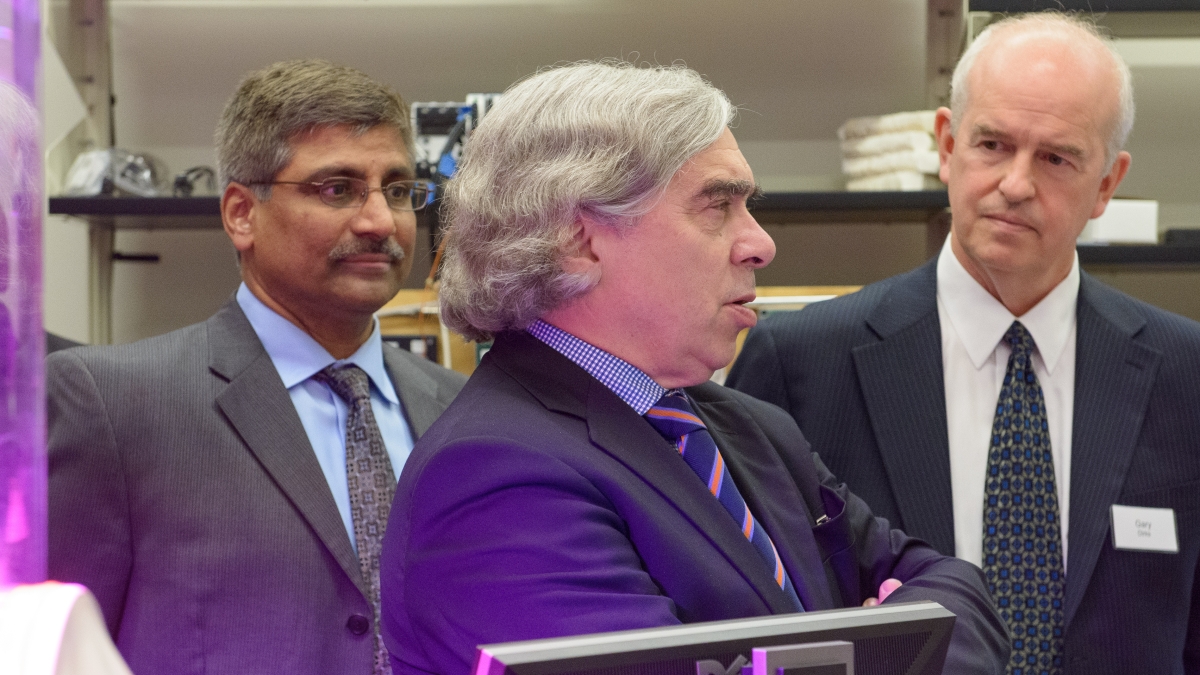US Secretary of Energy visits ASU to tour research projects, meet with STEM students

U.S. Secretary of Energy Ernest Moniz recently visited Arizona State University to meet with STEM (science, technology, engineering and math) students, and explore Department of Energy research projects at the university.
Moniz discussed energy and technology programs that the department supports at the university, and the importance of engaging youth and minorities in STEM education.
“Arizona State is among the leaders in innovation in energy technology,” Moniz said. “In the last decade, the Department of Energy has awarded Arizona State almost $100 million dollars in energy technology grants.”
Driving research that produces new energy technologies is an important aspect of the future, as is encouraging students to pursue studies in careers that focus on STEM fields.
“As we look forward, we need a good pipeline of STEM-based talent,” Moniz added.
During a tour of research projects at ASU, Moniz was able to witness groundbreaking endeavors, such as the Center for Negative Carbon Emissions, which advances carbon management technologies that can capture carbon dioxide directly from ambient air. The center addresses the root cause of climate change by recapturing carbon dioxide from the atmosphere through affordable air capture technology.
Additional research projects explored on the tour included Zero Mass Labs, a new research organization affiliated with ASU, whose projects focus on economic, environmental and social impact. One of the projects developed in Zero Mass Labs includes high-performance batteries that will serve simultaneously as energy storage and structural supports, while changing the shape of energy storage.
Photovoltaic installations and research information was also presented during the secretary’s tour. ASU is advancing solar energy through innovative research projects and in the operation of its numerous solar installations across all fours of its campuses.
As part of his visit, more than 20 American Indian students and students studying topics connected to Native lands presented their STEM-related research to Secretary Moniz.
“We are thrilled to have more than 2,400 students representing a variety of Native nations at ASU. This number has almost doubled in the past 10 years, which is aligned with the New American University mission to provide access to all qualified students focused on blending indigenous ideas with modern technology and innovation, such as the birth of the modern canal system, drawing inspiration from the Hohokam,” said Sethuraman "Panch" Panchanathan, senior vice president of Knowledge Enterprise Development at ASU.
“We are also thrilled that the Secretary of Energy had an opportunity to visit and experience the superior quality ideas, entrepreneurial spirit and the commitment to societal impact of our faculty and students. We are grateful for over $100 million of investments in energy-related research projects that result in meaningful solutions,” he added.
A sampling of student projects included Lynette Pollari’s project, Dine Cultural Sustainability Through Settlement Form, which examines residential subdivision development within the sacred landscape of the Navajo people, with shrinking cultural terrain from thousands of acres per extended family to less than half an acre per family today, leaving little room for planting or grazing.
Pollari, a Herberger Institute for Design and the Arts doctoral student, proposes a solution through the development of principles for a Navajo-driven residential zoning code that will address indigenous planning issues of cultural space, place, activity, extended family living, economy, ceremony and seasonal change.
Courtney Betoney, who is majoring in mechanical systems at the Ira A. Fulton Schools of Engineering, presented her research on CAREER: Engineering Design Across Navajo Culture, Community, and Society, which demonstrates how Navajo students and professionals experience, understand and apply engineering design in the context of their culture, community and society. This understanding then informs her design of engineering curricula that teaches Navajo culture and engineering in a holistic way. The curricula will be piloted in Navajo Nation middle school science classrooms.
Chrissy Foster, a doctoral student in the Mary Lou Fulton Teachers College, is addressing a need for educational innovations in engineering curricula to support Native American students in their development as innovators and creative thinkers within engineering, strengthened by their cultural background to support community development through engineering design.
Her dissertation explores innovative practices of Native American engineers and technical professionals, including problems that are solved, design approaches and how culture informs the work. The study seeks perspectives and experiences of Native American leaders within the engineering field to better understand innovative practices being applied to engineering, and how culture informs the practices, thereby showing its richness, depth and complexity.
Sri Harsha Kolli and Kaene Antonio, students in the Ira A. Fulton Schools of Engineering, presented a poster on research on a solar-wind-battery hybrid system and a reliability check of systems installed in remote locations of the Navajo Nation in comparison to the weather data at the same location. A major focus of the research is to educate young people living on the reservation about the system and encourage them to focus on STEM majors.
“Having Secretary Moniz visit ASU and engage with American Indian students on campus is an honor. It also allows ASU to present the high-level work of its Indigenous students. As an institution, we recognize that the future of tribal nations is rooted in energy and its engagement in particular places,” said Bryan Brayboy, Borderlands Professor of Indigenous Education and Justice in the School of Social Transformation at ASU.